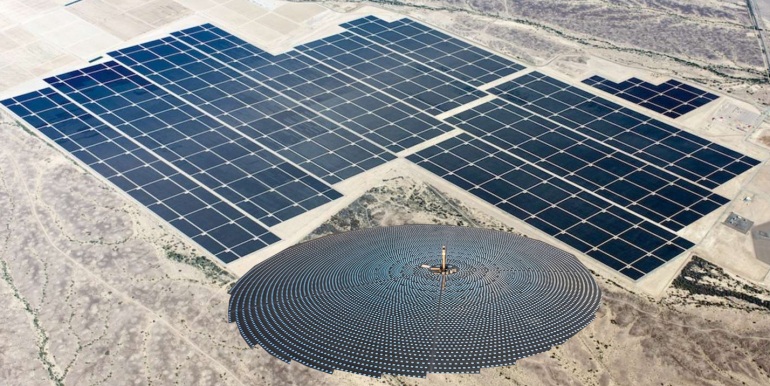The PV path to solar baseload at Port Augusta
The repowering of Port Augusta’s coal power plants with solar thermal has captured the imagination of thousands across the nation. In the last year, that enthusiasm has been turned into a serious effort to evaluate the opportunity for actually building a real, functioning plant – perhaps the first of many.
Since the beginning of the year, Alinta Energy – in a $2.4 million project co-funded by the Australian Renewable Energy Agency and South Australian government – has been investigating options for building a solar thermal power plant at Port Augusta as an initial step in replacing its ageing Northern and Playford brown coal-fired power plants.
In July, Alinta released its Milestone 2 Summary Report which said it had chosen to "continue the pre-feasibility study on the basis of a stand-alone power tower" – ruled out hybridisation with the existing coal-fired power plants, whereby it would displace some coal burning with solar-heated steam.
Alinta’s feasibility study was right to eliminate hybridisation of solar thermal with coal. It showed that it was a far more expensive option (as well as being the option that keeps Port Augusta’s coal burners unnecessarily on life support – delaying their inevitable closure and the full environmental and health benefits that go with it).
However, what the feasibility study failed to do is recognise another kind of hybrid: the hybrid solar thermal/PV plant.
A thermal/photovoltaic hybrid is, overall, a cheaper option than a straight-out stand-alone molten salt storage solar thermal central-receiver plant. Alinta should now incorporate this 'least-cost, maximum-benefit option' into its modelling, and present it to government for special consideration and funding.
Why would you build 2 types of solar plants together?
The solar industry is undergoing rapid change and improvement. In 2014 we can – ignoring wind power for a minute* – safely say the day (daytime generation period) has been won by solar photovoltaic technology.
As well as having the lowest levelised cost of energy of any renewable technology which reliably generates whenever the sun is up, projections from a range of expert groups show PV technology costs will continue to fall to become the cheapest of all renewable technologies. No future projections for the cost of solar thermal (during the day) are lower than projections for the future cost of PV generation.
Figure: 140MWe Solar Thermal / PV hybrid visualisation

Source: Zero Emissions Australia
So, if PV will always be cheaper than solar thermal and the cost gap is growing (mostly due to lack of serious systematic deployment of the latter) then solar thermal needs to be tailored to its strength – low cost energy storage. This allows it to provide reliable electricity generation after dark and firming power at times of low solar radiation (such as morning, early evening and when it’s cloudy).
For this reason, Alinta's proposal for solar thermal should be hybridised with PV to generate electricity during the daytime. If a baseload configuration is chosen for the plant (75 per cent annual capacity factor), modeling shows that about 47 per cent of generation of a hybrid PV/central receiver power tower located at Port Augusta would come directly from PV, with 53 per cent from solar thermal via its molten salt storage system.
If an intermediate plant configuration was chosen – where generation starts at 6am to deliver the morning peak and ceases at 11pm after we’ve all gone to bed – then 65 per cent of a hybrid solar thermal plant’s energy would come from a solar PV array.
The PV portion of a hybrid plant would be, ideally, configured with a solar array to an inverter ratio of 3:1. This would give about 200 per cent of the annual output of a traditional 1:1 ratio array (with same inverter capacity). This would work especially well when there is cloud cover; a significant design challenge for a conventional solar thermal plant which – unlike PV – can’t capture solar energy during cloudy periods (known as diffuse radiation). Indeed, the 'oversized' PV array portion of a thermal/PV hybrid plant would commonly produce more than 60 per cent of the plant’s rated output under cloudy conditions.
Oversizing the PV array portion of the plant is much like installing a backup generator for cloudy days and times of low generation. The extra panels can be thought of as a reserve plant that kicks in during the morning and afternoon when the sun’s available energy is lower. The reserve plant also kicks in when clouds come past. As stated previously, this reserve plant means that solar thermal hybridised with PV will usually produce more than 60 per cent of its rated output under the clouds, and commonly 100 per cent.
Another advantage of adding PV to a solar thermal plant to cover daytime operation is that a PV plant (including one on fixed arrays which is oversized) can be built considerably faster than a solar thermal generator. So almost half of the plant is generating revenue within a year of the capital being spent. This reduces financing costs and improves a project’s economics considerably. Also, much of the cost of a large-scale PV plant is 'balance of plant' costs and most of these are shared with the solar thermal plant.
An off-the-shelf molten salt solar thermal plant with storage configured for baseload operation (75 per cent capacity factor) from US based Solar Reserve would have a net turbine rating of approximately 140MWe and lay adjacent to a fixed array of 450MW of photovoltaic with 140MW of inverter capacity. That is the kind of project Alinta and the Port Augusta community should be proposing for government backing, if they want to demonstrate how solar can generate power day and night.
Matthew Wright is executive director of Zero Emissions Australia and a resident columnist at Climate Spectator.
*Wind is more of a fuel saver and doesn’t generate on a daily cycle like PV or solar thermal but, nonetheless, is a great source of renewable energy when evaluated with broader criteria (but due to limited space is not discussed here).
















